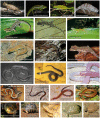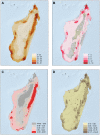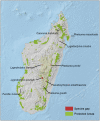Extinction risks and the conservation of Madagascar's reptiles
- PMID: 25111137
- PMCID: PMC4128600
- DOI: 10.1371/journal.pone.0100173
Extinction risks and the conservation of Madagascar's reptiles
Abstract
Background: An understanding of the conservation status of Madagascar's endemic reptile species is needed to underpin conservation planning and priority setting in this global biodiversity hotspot, and to complement existing information on the island's mammals, birds and amphibians. We report here on the first systematic assessment of the extinction risk of endemic and native non-marine Malagasy snakes, lizards, turtles and tortoises.
Methodology/principal findings: Species range maps from The IUCN Red List of Threatened Species were analysed to determine patterns in the distribution of threatened reptile species. These data, in addition to information on threats, were used to identify priority areas and actions for conservation. Thirty-nine percent of the data-sufficient Malagasy reptiles in our analyses are threatened with extinction. Areas in the north, west and south-east were identified as having more threatened species than expected and are therefore conservation priorities. Habitat degradation caused by wood harvesting and non-timber crops was the most pervasive threat. The direct removal of reptiles for international trade and human consumption threatened relatively few species, but were the primary threats for tortoises. Nine threatened reptile species are endemic to recently created protected areas.
Conclusions/significance: With a few alarming exceptions, the threatened endemic reptiles of Madagascar occur within the national network of protected areas, including some taxa that are only found in new protected areas. Threats to these species, however, operate inside and outside protected area boundaries. This analysis has identified priority sites for reptile conservation and completes the conservation assessment of terrestrial vertebrates in Madagascar which will facilitate conservation planning, monitoring and wise-decision making. In sharp contrast with the amphibians, there is significant reptile diversity and regional endemism in the southern and western regions of Madagascar and this study highlights the importance of these arid regions to conserving the island's biodiversity.
Conflict of interest statement
Figures






References
-
- Kiester AR (1971) Species density of North American amphibians and reptiles. Systematic Zoology 20: 127–137.
-
- Pianka ER (1972) Zoogeography and speciation of Australian desert lizards: An ecological perspective. Copeia 1972: 127–145.
-
- Buhlmann KA, Akre TSB, Iverson JB, Karapatakis D, Mittermeier RA, et al. (2009) A global analysis of tortoise and freshwater turtle distributions with identification of priority conservation areas. Chelonian Conserv Biol 8: 116–149.
-
- Schall JJ, Pianka ER (1978) Geographical trends in numbers of species. Science 201: 679–686. - PubMed
-
- Hawkins BA, Field R, Cornell HV, Currie DJ, Guégan JF, et al. (2003) Energy, water, and broad-scale geographic patterns of species richness. Ecology 84: 3105–3117.
Publication types
MeSH terms
LinkOut - more resources
Full Text Sources
Other Literature Sources

